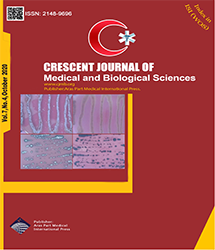| Original Article | |
| Caffeine Effect as Confounding Factor in Sepsis Diagnosis by Heart Rate Signal Processing | |
| Amid Maghsoudi1, Mohammad Heidarzadeh2, Abolfazl Afjeh3, Parinaz Alizadeh4, Abbas Abaei Kashan5, Arash Bordbar6, Kayvan Mirnia7 | |
| 1Department of Mechanical Engineering, Tehran University of Medical Science, Tehran, Iran 2Department of Pediatrics, Pediatric Health Research Center, Tabriz University of Medical Science, Tabriz, Iran 3Department of Pediatrics, Shahid Beheshti University of Medical Sciences, Tehran, Iran 4Department of Pediatrics, Faculty of Medicine, Mofid Children Hospital, Shahid Beheshti University of Medical Science, Tehran, Iran 5Department of Mechanical Engineering, Iran University of Science and Technology, Tehran, Iran 6Department of Pediatrics, Akbar Abadi Hospital, Iran University of Medical Sciences, Tehran, Iran 7Department of Pediatrics, Tehran University of Medical Science, Tehran, Iran |
|
|
CJMB 2020; 7: 510-517 Viewed : 5161 times Downloaded : 2981 times. Keywords : Caffeine, Sepsis, Diagnoses, Signal processing |
|
| Full Text(PDF) | Related Articles | |
| Abstract | |
Objectives: Apnea leads to respiratory arrest in premature infants, which decreases through the administration of caffeine by increasing the heart rate (HR). Nowadays, using electrocardiogram (ECG) signals, along with studying and comparing heart rate characteristics (HRC) in premature infants is considered as the most critical claim in the early detection of diseases, especially sepsis. Accordingly, this study investigated the effect of caffeine on HRC. Materials and Methods: To this end, the raw ECG data of infants were collected from the Akbarabadi neonatal intensive care unit section and then processed in time and statistical domain. Next, the effect of caffeine on their HRC was investigated, and finally, HRC signals were analyzed fifteen minutes before and immediately after caffeine administration. Results: Before caffeine administration, the probability distribution of inter-beat (RR) intervals and the probability distribution of the R2/R1 ratio were close to the normal distribution. According to previous studies, the irregularity of the signal in the diagram of the beat to beat RR interval indicates the infant health. However, these diagrams showed an abnormal distribution, and a specific uniformity was observed in the RR interval diagram after the administration of caffeine. Conclusions: Based on the results of this study, changes in the infant"s HRC and its pattern should be identified after drug administration in order to evaluate the status of newborns, primarily through new methods of sepsis prediction in preterm infants. Eventually, the findings of this study enable clinicians to consider the drug effect as a confounding factor with a specific pattern in the signal without disconnecting diagnostic devices from infants for drug administration. |
Cite By, Google Scholar
Google Scholar
PubMed
Online Submission System
 CJMB ENDNOTE ® Style
CJMB ENDNOTE ® Style
 Tutorials
Tutorials
 Publication Charge
Medical and Biological Research Center
About Journal
Publication Charge
Medical and Biological Research Center
About Journal
Aras Part Medical International Press Editor-in-Chief
Arash Khaki
Deputy Editor
Zafer Akan


















